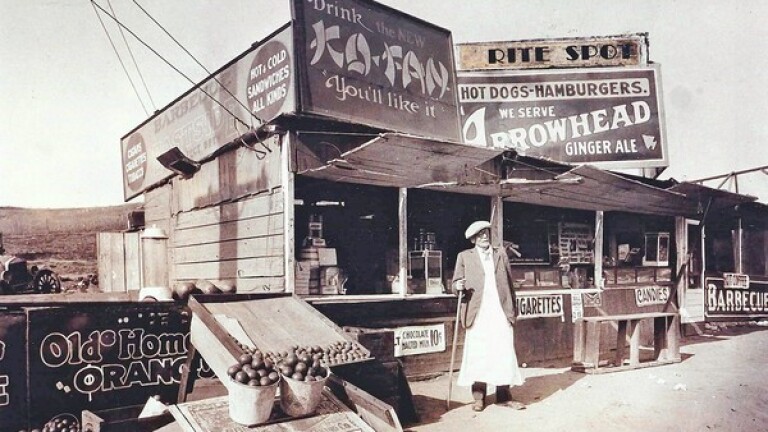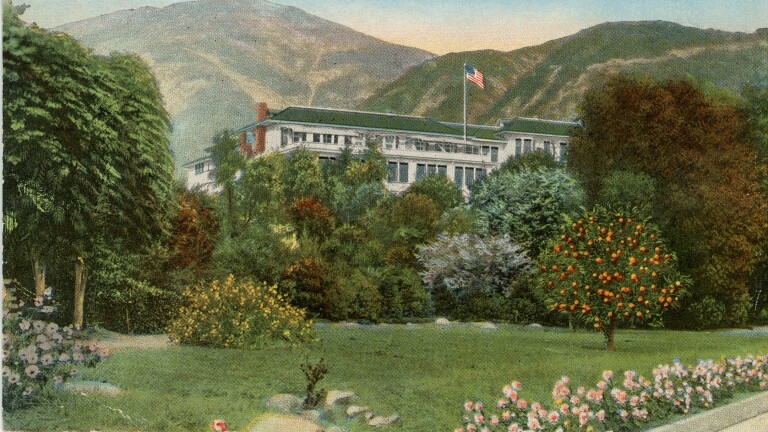Murder in Old Los Angeles

Union Bank is a proud sponsor of Lost LA. 
The Los Angeles that reinvented itself in the late 1880s as an amalgam of sunny romance and real estate speculation had little use for its more recent past as a rough cowtown at the margin of the Old West. From the end of the Mexican War (1848) to the arrival of the transcontinental railroad and respectability (1876), Los Angeles drank, whored, brawled, lynched, and murdered.
Hollywood's movie makers would wholesale stories of an epic West (beginning with "In Old California" in 1910), but that epic left out the kind of occupied city that Los Angeles had been – a city so violent that James M. Guinn, writing for the Historical Society of Southern California in 1894, claimed a common greeting on the streets of Los Angeles had been: "Well, how many were killed last night?"
John A. Lewis, editor of the Los Angeles Star in 1853, complained:
There is no brighter sun, no milder clime, no more equable temperature, no scenes more picturesque, no greener valleys, no fairer plains in the wide world, than those we may look upon here, There is no country where nature is more lavish of her exuberant fullness; and yet, with all our natural beauties and advantages, there is no country where human life is of so little account. Men hack one another to pieces with pistols and other cutlery as if God's image were of no more worth than the life of one of the two or three thousand ownerless dogs that prowl about our streets and make night hideous.
A decade later, as the number of murders began to climb again, the Los Angeles News commented, "We are reminded of former days when it was usual to find from one to three, and as often, a half dozen dead bodies in the streets who had been murdered the night previous."
Other chroniclers of Los Angeles – from the wildly unreliable Horace Bell to the careful Harris Newmark – counted the shot, stabbed, and bludgeoned to death and arrived at an astonishing 300 killings a year in a county that had fewer residents in 1850 than Avalon has today.

The actual number turns out to be far less, but bloody enough. The late historian Eric Monkkonen, using official sources and other accounts (while noting their defects) estimated that 389 killings had occurred between 1830 and 1874 within the loosely drawn boundaries of Los Angeles County. Yale professor John Mack Faragher, examining these data further, calculated a higher total: 468 reliably recorded homicides in.
The contrast between the Mexican period (between 1830 and 1846) and the start of the American period (1847 to 1874) is startling: about two murders a year in Mexican Los Angeles compared to an average of about 17 a year in the newly Americanizing town.
The increase in murders came in waves. Monkkonen found heightened levels of homicide in 1847, the mid-1850s, and 1870 (his ending year). The worst years for murder in old Los Angeles were the mid-1850s.
Compared with cities on the East Coast, Los Angeles for a generation was extraordinarily violent, even more violent at times than frontier towns more famous in Western lore.
Irony served the city as an antidote. Either as morbid humor or a terrible marketing idea, the owner of the Mammoth Saloon at the junction of Spring and Main streets claimed that his neighborhood was unusually quiet. "A word to the wise is sufficient," his advertisement ran. "No killing at 300 yards here."
They didn't meet at high noon. That was an invention of dime novels and then the movies. Death was at arm's length, even when accompanied by gunfire.
The murder weapon most used in Los Angeles after 1850 was the mass-produced handgun. The most likely situation for murder was a bout of drinking gone on too long and then gone bad. The killers and the dead were typically young men. They didn't meet at high noon. That was an invention of dime novels and then the movies. Death was at arm's length, even when accompanied by gunfire.
After 1847, 29 percent of homicide victims were Native American and 34 percent Mexican American. The Anglo population of Los Angeles was relatively small well into the 1860s, but about 40 percent of all those killed were Anglo between 1847 and 1870, as was the percentage of their killers. (Not all the suspects in every murder were known, however.)
Lethal violence in Los Angeles wasn't confined to barroom brawls. The little town's citizens – sometimes even its elected officials and police – also joined in. Guinn, glossing over the racial and social realities of lynch "justice" in mid-19th century Los Angeles, claimed:
The criminal element became bold and defiant; robbers and murderers terrorized the community. Then the law-abiding citizens arose in their might and in the shape of vigilance committees and military organization put an end to the saturnalia of crime and to many of the criminals as well. The gallows tree on Fort Hill bore gruesome fruit and the beams over corral gates were sometimes festooned with the hangman's noose. In less than a year, twenty-two criminals, bandits, murderers and thieves, were hung in accordance with the laws or without law whichever was most convenient or most expeditious; and more than twice that number expatriated themselves for the country's good, and their own.
In November 1853, the New York Times dryly reported that an "impromptu Vigilance Committee forced open the Los Angeles jail on Saturday morning, taking therefrom five prisoners charged with murder, highway robbery, and horse-stealing. The committee then hung the prisoners under the corridor in front of the jail...Business was suspended in Los Angeles on the occasion, but the...whole affair passed off with little or no excitement."
Between 1851 and 1874, according to the Los Angeles County Sheriff's Department, Los Angeles saw 40 legal hangings, 38 mob lynchings, and 32 hangings by the city's "organized" vigilance committees. Included in this count is the murder of at least 19 Chinese immigrants in 1871 in the city's worst example of communal violence.

As Karen Wilson and Daniel Lynch noted in these pages in 2015, the agents of vigilance in Los Angeles were often the "boys" from El Monte. Sometimes admired, sometimes satirized as inept, the Monte boys continued to render sudden violence by gun or rope until as late as 1887.
Killings and vigilantism persisted in Los Angeles for many reasons, according to Monkkonen. Boomtown transience, he believed, was one factor. A disproportionate number of footloose young males was another. But the city's tiny law enforcement presence and lax city and county governments also allowed individual and group violence to become a lethal part of the city's culture.
Monkkonen concluded his analysis with a bleak image of mid-19th century Los Angeles:
The typical mid-nineteenth-century Angeleno lived in a place rife with homicides in both the Mexican and American eras. Sometimes the victims were limited to particular social groups, and most of the time they were men. But whether or not one was at risk, one had to know that violence was common and tolerated. The city, its surrounding hamlets, and the rural countryside were all places with little government, weak law enforcement, high transiency, anonymity, and, apparently, elite tolerance of violence.
Editor's note: This article was originally published on Feb. 24, 2016.





